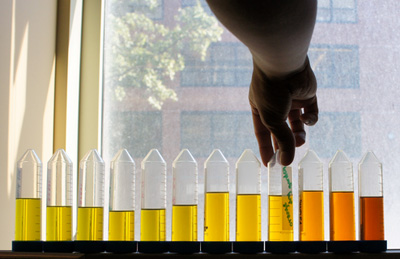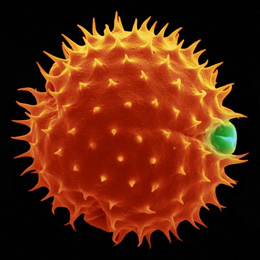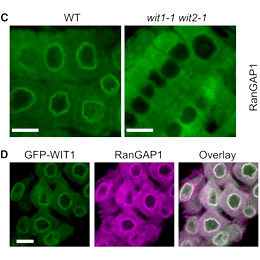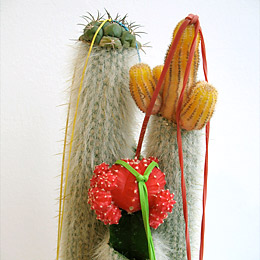The
Ohio State University > Department
of Art > Art & Technology +
Molecular Genetics
SYLLABUS
ARTSCI
5194 Arts and Sciences Interdisciplinary Group Studies
Harvesting Color: the art and science of plant/human relationships
|
|
|
Carmen
login |
|
|
|
|
Creativity
is intelligence having fun – Albert Einstein
The
most important expression in scientific discovery is not "Heureka!" but "This
is strange...?" – Isaac Asimov
Course
Description
Using artistic and scientific methods students will investigate
relationships between plants and people, with specific attention
to color. Through experimentation and aesthetic research, the value
and use of plant pigments will be examined, manipulated and creatively
represented.
Course Meeting Time and Locations
Mon/Wed, 4:00 - 7:00 Jennings 014 & Hopkins Hall 146.
Please note the 2 locations, we will move between them and keep you
updated as to where class meetings will be held. Please check the
schedule outline below and/or Carmen.
Instructors
Iris Meier, Professor
of Molecular Genetics
email: meier.56@osu.edu
Office:
520 Aronoff Labs, ph: 2-8323
Amy
Youngs, Associate Professor of Art
email: youngs.6@osu.edu -
best way to contact me
ph: Art
Department (614) 292-5072 - a place to leave messages for me.
Office: Hopkins Hall, room 150. Mailbox: 258 Hopkins Hall
Objectives
- Demonstrated ability to apply both artistic and scientific methods
to a project
- To gain an understanding of the cultural, economic, medical and
aesthetic connections between humans and plants
- To create an artwork that reveals and presents the student’s
investigations
Course Content and Procedures
We will take students through the experience of man’s connection
to and use of plants, focusing on one example and expanding from
it. The example will be the use of common Marigold flowers to make
two products used nutritionally and aesthetically by people. Marigolds
are widely used by different cultures as ornamental and ceremonial
flowers. The first product is the yellow compound Lutein, which is
marketed in health-supplement stores as a protective agent against
age-related macular degeneration. The concept of a yellow pigment
being causally involved in human vision will here be explored. The
second is a yellow dye that can be used to dye silk and wool, and
can be seen as an example of the rich history of the use of plant
and animal-based natural dyes. The interconnectedness of the two
compounds and their use will be explored. The course will have a
scientific and an artistic component. Students will harvest fresh
flower petals, as it is done in the fields of India where Marigold
is commercially grown for Lutein extraction. They will use simple
extraction procedures to enrich and purify Lutein, will detect and
identify compounds in their extracts by thin-layer chromatography
and spectrophotometry, and will compare quantitatively and qualitatively
the “color yellow” they have harvested from the flowers.
The students will acquire methods used in this part in part by exploring
the patent literature, thus adding the layer “patents from
nature” to the themes explored. Using their extracts, they
will dye a material yellow, and appreciate the technical aspect of
light fastness of natural compounds used to color objects. We will
accompany this hands-on part of the course with the presentation
and discussion of literature selected to explore more deeply the
use of plants by people.
Artistic methods, such as observation, speculation, synthesis, manipulation,
construction and presentation, will be used to develop and create
an artwork generated by the course content.
Requirements and Evaluation
40% Final project, presented in art exhibition
20% Detailed research notebook, including images, observations, sketches,
maps and reflections.
20% Written scientific report 2 – 3 pages (guidelines
posted here).
20% Active participation in class activities and discussions
Texts
There will be required and optional readings in this course. The
required portions will be available online, in our Carmen resources,
or in the library. Check
the schedule for details. Inspirations/bibliography for this class:
Gessert, George, Green
Light: Toward an Art of Evolution, MIT
Press, 2010.
Wilson, Stephen, Art+Science
Now, Thames & Hudson, 2010.
Mitchell, Robert, Bioart
and the Vitality of Media, University of Washington Press,
2010.
Anker, Suzanne and Nelkin, Dorothy, The
Molecular Gaze: Art in the Genetic Age, Cold Spring Harbor, N.Y:
Cold Spring Harbor Laboratory Press, 2004
Pollan, Michael, Botany
of Desire: A Plant's Eye View of the World. New York: Random
House, 2001.
Anderson, Edgar, Plants, Man and Life, Dover, 2005 (1971 originally)
Hobhouse, Henry, Seeds of Change: Six Plant that Transformed Mankind,
Counterpoint, Berkeley, CA, 2006
Attendance policy
Don't miss class. Don't arrive late or leave early. You
are expected to come to class on time, ready to work, discuss or
present, depending on what is scheduled that day. Your final grade
will be lowered by one full letter upon your fourth absence - and
again for each additional absence. 4 late arrivals or early departures
= 1 absence. Absences are absences, whether or not you have a note.
Please use your 3 allowed absenses wisely. You are responsible to
find out what you missed and to complete any missed work.
Disability policy
Students with disabilities that have been certified by the Office
for Disability Services will be appropriately accommodated, and should
inform the instructor as soon as possible of their needs. The
Office for Disability Services is located in 150 Pomerene Hall, 1760
Neil Avenue; telephone 292-3307, TDD 292-0901; http://www.ods.ohio-state.edu/
Academic misconduct
It is the responsibility of the Committee on Academic Misconduct
to investigate or establish procedures for the investigation of all
reported cases of student academic misconduct. The term “academic
misconduct” includes all forms of student academic misconduct
wherever committed; illustrated by, but not limited to, cases of
plagiarism and dishonest practices in connection with examinations.
Instructors shall report all instances of alleged academic misconduct
to the committee (Faculty Rule 3335-5-487). For additional information,
see the Code
of Student Conduct.
|
| |
|
|
|
|
| Schedule
overview |
| DATE
/ PLACE |
ACTIVITES |
COURSE
MATERIALS TO READ / WATCH BEFORE CLASS |
MON
Jan 6 Jennings
014 |
Snow day. |
|
WED
Jan 8 Jennings
014 |
Introduction - Plants
and humanity.
Introduce Artistic strategies and research notebook concept. Bring notebook for
next class and every class. |
Culture:
Artist in the Lab, by Martin Kemp. Article in the journal, Nature
(you need to log into the OSU library for this) Optional: select
from a variety of plant biology textbooks for background study, primary
literature, patents, we will make available in the classroom and in Carmen |
MON
Jan 13
Jennings
014 |
Greenhouse tour at
4pm. Observe plants, photograph and/or draw them. Record
in research notebook.
River
of Gold,
each student brings 5 yellow/gold objects from home for an in-class taxonomy
exercise. |
Listen:
Radiolab episode on color:
http://www.radiolab.org/2012/may/21/ |
WED Jan 15
Jennings 014 |
Introduction - Marigolds-
aesthetic, ritual, and practical uses. Introduction to an artmaking
protocol for diagramming, planning and executing an art/science
project. |
Look
through the articles in the "Marigold Literature and Information" section
in the Carmen content area and choose one or two to read. We will discuss.
Watch: A
plant’s-eye view, Ted Talk by Michael Pollan Optional reading:
The Tulip (pg 61- 110), in The Botany of Desire, Pollan, Michael. |
– MON
Jan 20 |
MLK Day, no classes. |
|
WED
Jan 22Jennings 014 |
Students chose their
experimental set-up. Start extraction. |
Read
patents
and primary literature about Lutein extraction and
crystallization. |
MON
Jan 27Jennings 014 |
Color extracts and
chromatography. Present creative process diagram
in class. |
Create
your own creative process diagram and present it in class. |
WED
Jan 29Jennings 014 |
Discuss TLC results.
Discuss reading. Students present inital artwork concepts. |
Read Rainforests
of Domestication, (pg 21 - 31) in the book, Green Light,
Toward an Art of Evolution, by George Gessert. |
MON Feb 3Jennings
014 |
Run additional TLC
experiments. The use of natural dyes. |
Read
saponification paper posted in Carmen. |
WED
Feb 5Jennings 014 |
Characterize color
extracts – spectrophotometry. Students form initial working groups
based on artwork concepts. |
|
MON Feb 10
Jennings 014 |
Guest lecture: Dr
Rebecca Lamb. The biology of flowers. Student presentations. |
Prepare
presentations on art questions |
WED
Feb 12Jennings 014 |
The mysterious
world of pollen, a guest lecture by Anya Dobrista. Lab work
with saponification. |
|
MON Feb 17
Jennings 014 |
Student groups present
art concepts to class. Decide as a class on which projects to focus
on and form new working groups. |
Prepare
group presentations on group art concepts |
WED Feb 19
Jennings 014
|
Characterize color
extracts – thin layer chromatography. Art project working
groups present their preliminary research and timelines for further
experiments. Discussion of artistic experimentation. |
Work on
art experiments, prepare to discuss. |
MON Feb 24
Jennings 014 |
Group interpretation
and presentation of scientific results. Discussion about what experiments
should be run next. |
|
WED Feb 26
Jennings 014 |
Crystallize Lutein.
Groups also work on art projects. |
|
MON Mar 3
Jennings 014 |
Working groups present/discuss
progress. |
|
WED Mar 5
Jennings 014 |
Mordant fabrics/materials.
Students bring their materials to prepare for dye. Next science experiments
are run. |
|
– Mar 10 -
14
|
SPRING BREAK,
no classes |
|
MON Mar 17
Jennings 014 |
Make aqueous extracts
from dye plants, set up dye vats.
|
|
WED Mar 19
Hopkins 146 |
Working groups present/discuss
progress |
|
MON Mar 24
Jennings 014 |
Continue to work
on dye vats |
|
WED Mar 26
Hopkins 146 |
Setting up art projects
on site |
|
MON Mar 31
Hopkins 146 |
Working groups present/discuss
progress. |
|
WED Apr 2
Hopkins 146 |
Working groups present/discuss
progress.
|
|
MON Apr 7
|
Science
report due today, submit into Carmen dropbox. Working groups
present/discuss progress |
|
WED Apr 9
Hopkins 146 |
Work day on art projects |
|
MON Apr 14
Hopkins Hall gallery |
Critique of art
project on site |
|
WED Apr 16
Hopkins Hall gallery |
Fine tune art projects |
|
MON Apr 21
Hopkins Hall gallery |
Set up exhibition
in Hopkins Hall gallery and collaboratory |
|
TUES Apr 22
Hopkins Hall gallery |
Public exhibition
opening celebration from 5 - 8pm. Invite your friends and family!
Exhibition
will have additional open hours Wed through Fri. |
|
FRI Apr 25
Hopkins Hall gallery |
Exhibition has open
hours from 11 - 4pm, then must be de-installed at 4pm. Cleanup space
and remove all materials. |
|
| |
|
| This
schedule is subject to change - check Carmen and stay alert in
class for updates as we go. |

Course
handouts
Marigold
Dye Project
Yellow
Dye Extraction from Tagetes Erecta
How to write a science
report
Artmaking protocol
Creative process diagram
Creative conceptual strategies
Related blogs, articles, videos and other online resources
Antennae, The
Journal of Nature in Visual Culture. Online journal, 2007 - ongoing.
Art
and Genetics Bibliography, Compiled by George Gessert
Next Nature
Is this Bioart?
Spaid, Sue Ecovention,
Current Art to Transform Ecologies, Contemporary Arts Center,
June 2002.
Stephen
Wilson's links for artworks at the intersection of Biology: Microbiology,
Bioengineering, Stem Cells; Biology: Animals & Plants; Ecology;
Body & Medicine
Art
+ Science resource links from Steve Wilson's book of the same name
Vilem Flusser, Curie's
Children, * Early speculations about genetic art, first published
in Art Forum, October 1988, p. 9
Haeckel, Ernst Art
Forms in Nature, Dover Publications; Rev Ed edition 1974, originally published
in 1904 - that version is in the public domain and online
here
Plants-in-Motion,
time-lapse videos by Roger P. Hangarter
Gift of Green,
film from 1946. "The power of our complex age,
we owe to the green plants"
BBC How to Grow a Planet, Life
from Light full hour show.
Iris' Plantarium news
Plant biology resources
Plants
and Energy - Miscanthus Research into biofuels
Bill Gates and Plants
The Arabidopsis Book
More Genes Than Humans: The Tomato Decoded
ASPB Blog: Plants in the News
Botany
Online - the internet hypertextbook
|
Artists
and related projects
Mark
Dion - video of Neukom Vivarium Nurse
log greenhouse
project in Seattle starts at 5'30"
George
Gessert - breeding flowers as an artform
Tiddo Bakker - Message in a vein, a project to show plant reactions
in a way that is visible to humans
Wolfgang
Laib - plant pollen installations
Helen
Mayer Harrison and Newton Harrison - eco-art pioneers who
think of the ecosystem as their client when accepting commissions.
Heather Ackroyd & Dan
Harvey - installations and imagery on photosensitive
grass
Aurora Robson - plastic trash turned into fantastical representations of the organic
Bill Smith - Art/Science
inspired installations
Biomodd - symbiotic installations connecting people, computers
and plants. Collaborative project led
by Anthony Vermeulen
Rectified
Flowers - panaramic photos from inside the flower
After
Agri -
an opera singer forms a unique relationship with algae
Golden
Spider Silk, by Simon Peers and Nicholas Godley
Natural
History of the Enigma, by Eduardo Kac
Common
Flowers / Flower Commons, by Shiho Fukuhara and Georg
Tremmel
Interactive
Plant Growing, by Christa Sommerer and Laurent Mignonneau
|
Exhibitions
and Conferences
Grow
Your Own: Life after nature, Science Gallery
Trinity College, Dublin, Ireland. Jan 2014
Bio:Fiction
Science, Art & Film Festival, (films
online here). Was at the Museum of Natural
History in Vienna, Austria, May 2011
Visceral:
the living art experiment, Science Gallery Trinity College,
Dublin, Ireland, Feb. 2011
Dead
or Alive: Nature becomes Art, Museum of Arts and Design,
New York, NY 2010
sk-interfaces, Liverpool, UK, 2008 and Luxembourg, Belgium
2009
sLowlife, traveling
exhibition organized by US Botanic Garden, Chicago Botanic Garden
and Roger Hangarter 2006 - 2010
ART
et BIOTECHNOLOGIES, Conference and book, Montreal, Canada
2005
BioFeel
at the Biennale of Electronic Arts, Perth, Australia, 2002
Paradise
Now: Picturing the Genetic Revolution, New York, 2000
Botanica: Contemporary art and the world of plants, Tweed Museum
of Art, University of Minnesota Duluth, 1999
LifeScience, Ars
Electronica, Linz, Austria 1999
|
Related
Opportunities
Call
for Participation: Making Life - a research platform for art and
synthetic biology - Finnish
Society of Bio-Art
Bio-Fiction,
the International Synthetic Biology Science, Art and Film Festival
series is calling for submissions. It features short films on any
aspect of synthetic biology, including documentary films, animation,
(science) fiction etc. The
first festival was held in Vienna, Austria, in 2011. The Second
Bio-fiction Festival will take place from 23 - 25 October, 2014.
The Venue will again be the Museum of Natural History in Vienna,
Austria.
SymbioticA,
at the University of Western Australia, is an artistic laboratory
dedicated to the research, learning, critique and hands-on engagement
with the life sciences. Apply
for a residency.
Parco
Arte Vivente "Park of Living Art"in
Turin, Italy. An outdoor exhibition center, an interactive museum
and a center of research interested in the dialogue between contemporary
art, science, nature, biotechnologies and ecology.
|
Iris
Meier | Department of Molecular
Genetics | The
Ohio State University
Amy
Youngs | Art & Technology | Department
of Art | The Ohio State University |



